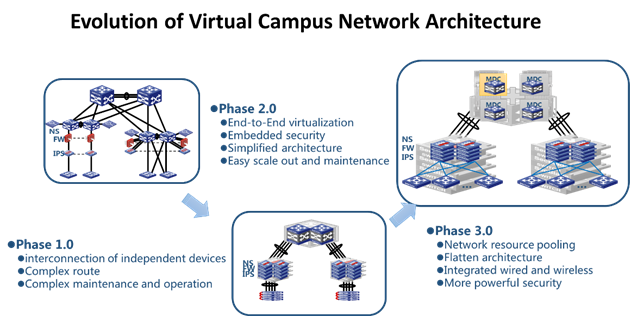Financial Virtual Campus Network Solution
16-05-2018Characteristics and Requirements of the Virtual Campus Network
With the rapid development of China's economy, financial enterprises have also expanded in turn. Constructing virtual campus network has led to new issues affecting various financial enterprises. To enhance their competitiveness and better manage and communicate with one another, it is necessary to dispel barriers between enterprises or departments to allow information to flow smoothly. This inevitably adds to the pressure IT departments face.
Characteristics and needs of the virtual campus networks are as follows:
The access points of traditional campus network STAs are mainly PCs. With the development of mobile Internet and rapid popularization of smart STAs, the access of smart STAs to the virtual campus network has become a common need.
The campus network scale is gradually expanding. In traditional networking solutions, a large number of access devices need to be initialized manually. The cost of operation and maintenance is quite high, and the virtual campus network requires the access layer to achieve automatic configuration management, unified management of global network versions, centralized configuration management, and unified maintenance.
In the traditional mode, application systems are mainly deployed in data centers. Currently, new applications for campus networks increase rapidly, and application deployment must be more flexible and quicker. Effective security isolation and controls are required according to the service types and the service departments.
In addition to network stability, users are also concerned about the intellisense of STA types, automatic authentication of STAs, and employee access to the company network securely anytime from anywhere.
With the increase of various types of STAs and complex applications, and the expansion of network sizes, it is necessary to further simplify the network structure and implement fine control of different types of devices.
Evolution of Virtual Campus Network Architecture

Constructing traditional campus networks focuses on the interconnection of independent devices. Service resources and STA resources distributed across the campus are integrated to realize a daily office environment and management. In phase 1.0 of the virtual campus network, the network architecture design is relatively simple. After that, it exposes the disadvantages of complex management and difficulties in operation and maintenance.
The advanced virtualization solutions introduced in phase 2.0 of the virtual campus network enable more end-to-end virtualization, simplify the network architecture, and reduce complexities in operations and maintenance across the entire network. The financial campus network has high security requirements. Therefore, while establishing the campus network embedded security can be adopted. Security service cards such as firewalls, IPS, and traffic analysis modules can be deployed at key positions to improve security and controllability. This deployment mode will not increase the difficulty of network operations and maintenance management.
Financial enterprises have stringent requirements for the standardization of information systems. In addition, due to extremely high service complexity, the information systems are required to adapt to a wide range of access scenarios and support flexible security control schemes and agile architecture adjustment methods. In phase 3.0 of the virtual campus network, based on virtualization and embedded security, network resource pool technology is introduced to satisfy what an agile architecture design needs and facilitate network expansion. While achieving secure isolation between departments, this phase also achieves resource integration and isolation using network resource pool technology.
In phase 3.0 of the virtual campus network , H3C provides a fully integrated wired and wireless network architecture to broaden the interconnection and improve office efficiency and achieves secure access for users with the help of user security management software.
Technical Support to Financial Virtual Campus Network
Longitudinal virtualization:On the basis of horizontal virtualization at the campus network level, VCF technology is used to achieve vertical virtualization. This can reduce the number of logical nodes and the network’s logic levels; therefore, simplifying network configuration and management.
MDC: Through MDC's 1:N virtualization technology, key services can be physically isolated. By cooperating with the horizontal virtualization technology, MDC technology allows the campus network to be scalable and flexible.
Automatic deployment:Based on a certain configurations, the BIMS, DHCP server, and access-layer devices can implement zero configurations, unified management of global network versions of online devices, and centralized configuration management and delivery.
BYOD:H3C BYOD can control the identity and rights of all kinds of smart devices that access the campus network, so that smart devices can securely access resources in compliance with existing security policies and be effectively monitored.
Integrated wired/wireless management:H3C's wired/wireless integrated campus network solution comprehensively considers deployment, application, and maintenance. By comprehensively considering the hardware, security, and management aspects, the solution ensures higher system capacity, performance, and reliability and achieves integrated device integration and management, user management, and security management for wired and wireless devices.
You can find excellent H3C partners, or you can become one of them to build a
partnership with H3C and share success together.
